如何运行评估并查看结果
重要
此功能目前以公共预览版提供。
本文介绍如何使用 Mosaic AI 代理评估来运行评估并查看结果。
若要运行评估,必须指定评估集。 评估集是用户对应用程序提出的一组典型请求。 评估集还可以包括每个输入请求的预期响应(基本事实)。 如果提供预期的响应,代理评估可以计算其他质量指标,例如正确性和上下文足够性。 评估集旨在通过对有代表性问题进行测试来帮助衡量和预测代理应用程序的性能。
有关评估集的详细信息,请参阅 评估集。 有关所需的架构,请参阅 代理评估输入架构。
若要开始评估,请使用 MLflow API 中的 mlflow.evaluate() 方法。 mlflow.evaluate() 计算质量评估以及评估集中每个输入的延迟和成本指标,并跨所有输入聚合这些结果。 这些结果也称为评估结果。 下列代码演示了调用 mlflow.evaluate() 的示例:
%pip install databricks-agents
dbutils.library.restartPython()
import mlflow
import pandas as pd
eval_df = pd.DataFrame(...)
# Puts the evaluation results in the current Run, alongside the logged model parameters
with mlflow.start_run():
logged_model_info = mlflow.langchain.log_model(...)
mlflow.evaluate(data=eval_df, model=logged_model_info.model_uri,
model_type="databricks-agent")
在此示例中,将 mlflow.evaluate() 计算结果记录在封闭的 MLflow 运行中,以及其他命令(如模型参数)记录的信息。 如果在 MLflow 运行之外调用 mlflow.evaluate(),它会启动新的运行并在该运行中记录评估结果。 有关 mlflow.evaluate() 的详细信息(包括有关运行中记录的评估结果的详细信息),请参阅 MLflow 文档。
要求
必须为工作区启用 Azure AI 支持的 AI 辅助功能。
如何为评估运行提供输入
可通过两种方式为评估运行提供输入:
提供先前生成的输出,以便与评估集进行比较。 如果要评估已部署到生产的应用程序的输出,或者要比较评估配置之间的评估结果,则建议使用此选项。
使用此选项,可以指定一个评估集,如以下代码所示。 评估集必须包含以前生成的输出。 有关更详细的示例,请参阅 示例:如何将以前生成的输出传递给代理评估。
evaluation_results = mlflow.evaluate( data=eval_set_with_chain_outputs_df, # pandas DataFrame with the evaluation set and application outputs model_type="databricks-agent", )将应用程序作为输入参数传递。
mlflow.evaluate()针对评估集中的每个输入调用应用程序,并报告每个生成的输出的质量评估和其他指标。 如果应用程序是使用启用了 MLflow 跟踪的 MLflow 记录的,或者应用程序是作为笔记本中的 Python 函数实现的,则建议使用此选项。 如果应用程序是在 Databricks 之外开发的或在 Databricks 之外部署的,则不建议使用此选项。使用此选项,可以在函数调用中指定计算集和应用程序,如以下代码所示。 有关更详细的示例,请参阅 示例:如何将应用程序传递给代理评估。
evaluation_results = mlflow.evaluate( data=eval_set_df, # pandas DataFrame containing just the evaluation set model=model, # Reference to the MLflow model that represents the application model_type="databricks-agent", )
有关评估集架构的详细信息,请参阅 代理评估输入架构。
评估输出
代理评估从 mlflow.evaluate() 数据帧返回其输出,并将这些输出记录到 MLflow 运行中。 可以在笔记本中或从相应 MLflow 运行的页面检查输出。
查看笔记本中的输出
以下代码演示了一些有关如何从笔记本中查看评估运行结果的示例。
%pip install databricks-agents pandas
dbutils.library.restartPython()
import mlflow
import pandas as pd
###
# Run evaluation
###
evaluation_results = mlflow.evaluate(..., model_type="databricks-agent")
###
# Access aggregated evaluation results across the entire evaluation set
###
results_as_dict = evaluation_results.metrics
results_as_pd_df = pd.DataFrame([evaluation_results.metrics])
# Sample usage
print(f"The percentage of generated responses that are grounded: {results_as_dict['response/llm_judged/groundedness/percentage']}")
###
# Access data about each question in the evaluation set
###
per_question_results_df = evaluation_results.tables['eval_results']
# Show information about responses that are not grounded
per_question_results_df[per_question_results_df["response/llm_judged/groundedness/rating"] == "no"].display()
数据 per_question_results_df 帧包括输入架构中的所有列,以及特定于每个请求的所有评估结果。 有关计算结果的更多详细信息,请参阅 LLM 法官如何评估质量。
使用 MLflow UI 查看输出
评估结果也可以在 MLflow UI 中找到。 若要访问 MLflow UI,请单击笔记本右边栏中的“试验”图标 ![]() ,然后单击相应的运行,或者单击运行
,然后单击相应的运行,或者单击运行 mlflow.evaluate() 的笔记本单元格的单元格结果中显示的链接。
查看单个运行的评估结果
本部分介绍如何查看单个运行的评估结果。 若要比较各运行的结果,请参阅 比较各运行之间的评估结果。
LLM 评委的质量评估概述
每个请求的法官评估在 databricks-agents 版本 0.3.0 及更高版本中可用。
若要查看评估集中每个请求的 LLM 判断质量概述,请单击 MLflow 运行页上的“评估结果 ”选项卡。 本页显示每个评估运行的摘要表。 有关详细信息,请单击运行的评估 ID。
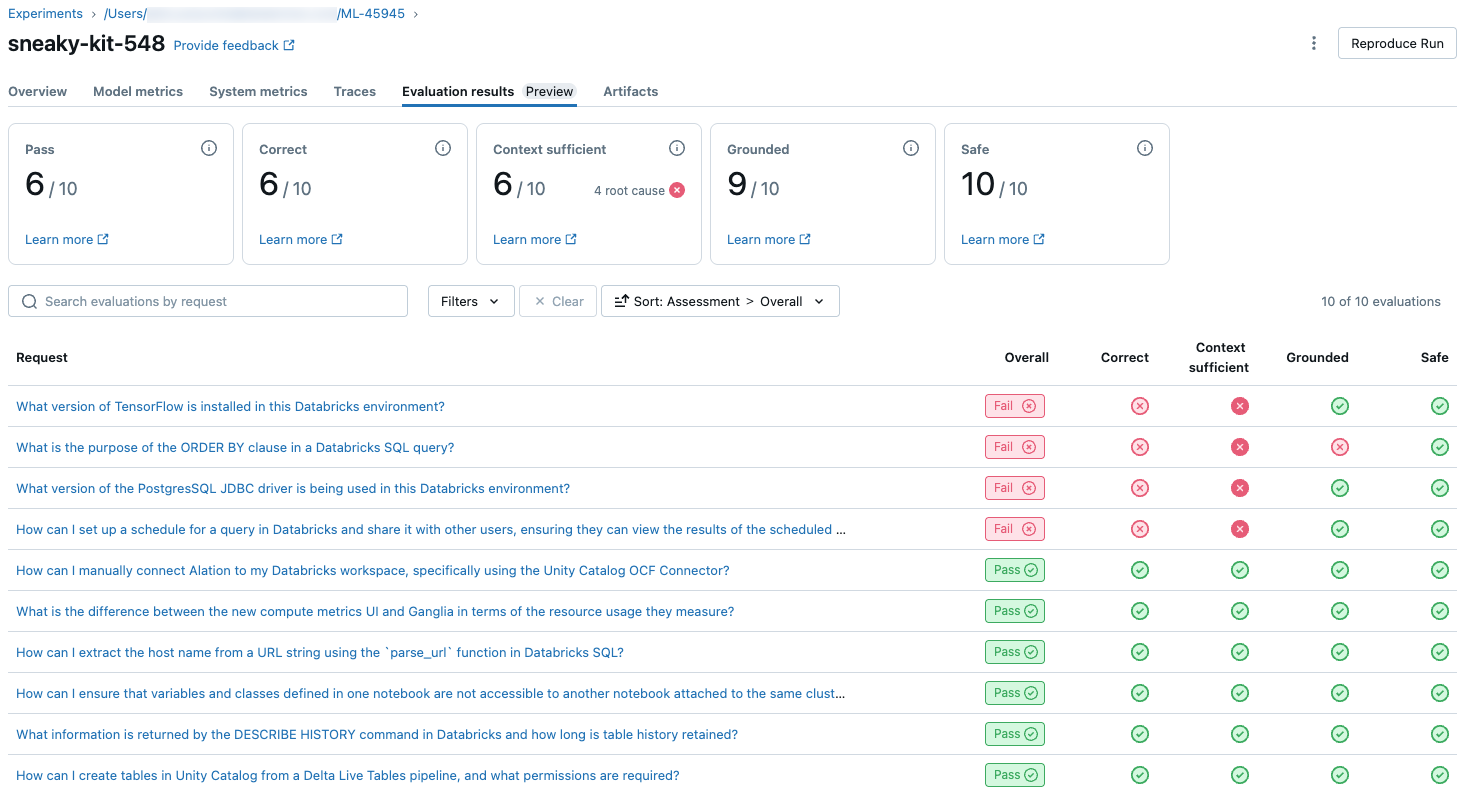
本概述显示每个请求的不同评委的评估、基于这些评估的每个请求的质量通过/失败状态,以及失败请求的根本原因。 单击表中的一行将带你访问该请求的详细信息页面,其中包括以下内容:
- 模型输出:代理应用生成的响应及其跟踪(如有包含)。
- 预期输出:每个请求的预期响应。
- 详细评估:LLM 的评估就是根据此数据判定的。 单击“查看详细信息”显示判定提供的理由。
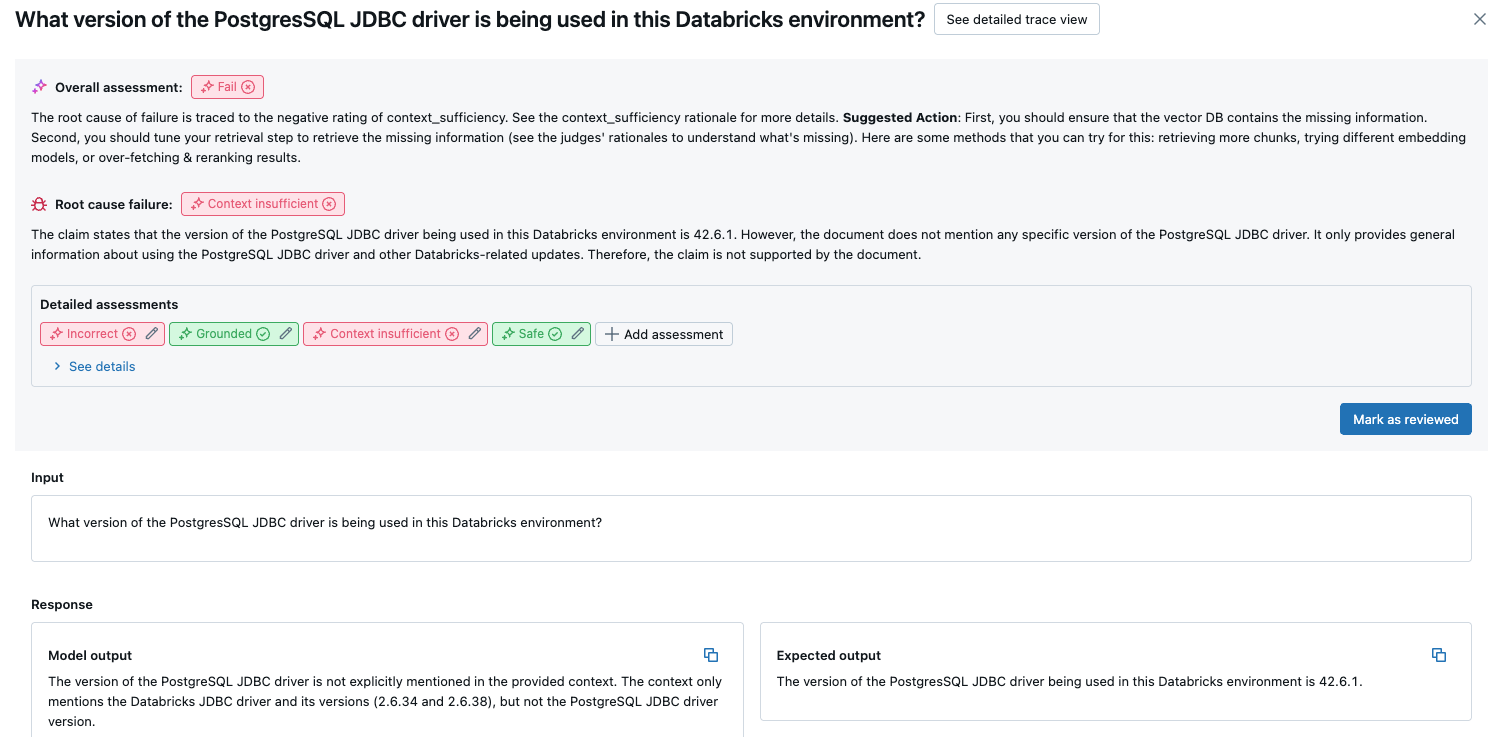
整个评估集的聚合结果
若要查看整个评估集的聚合结果,请单击“ 概述 ”选项卡(对于数值)或 “模型指标 ”选项卡(对于图表)。
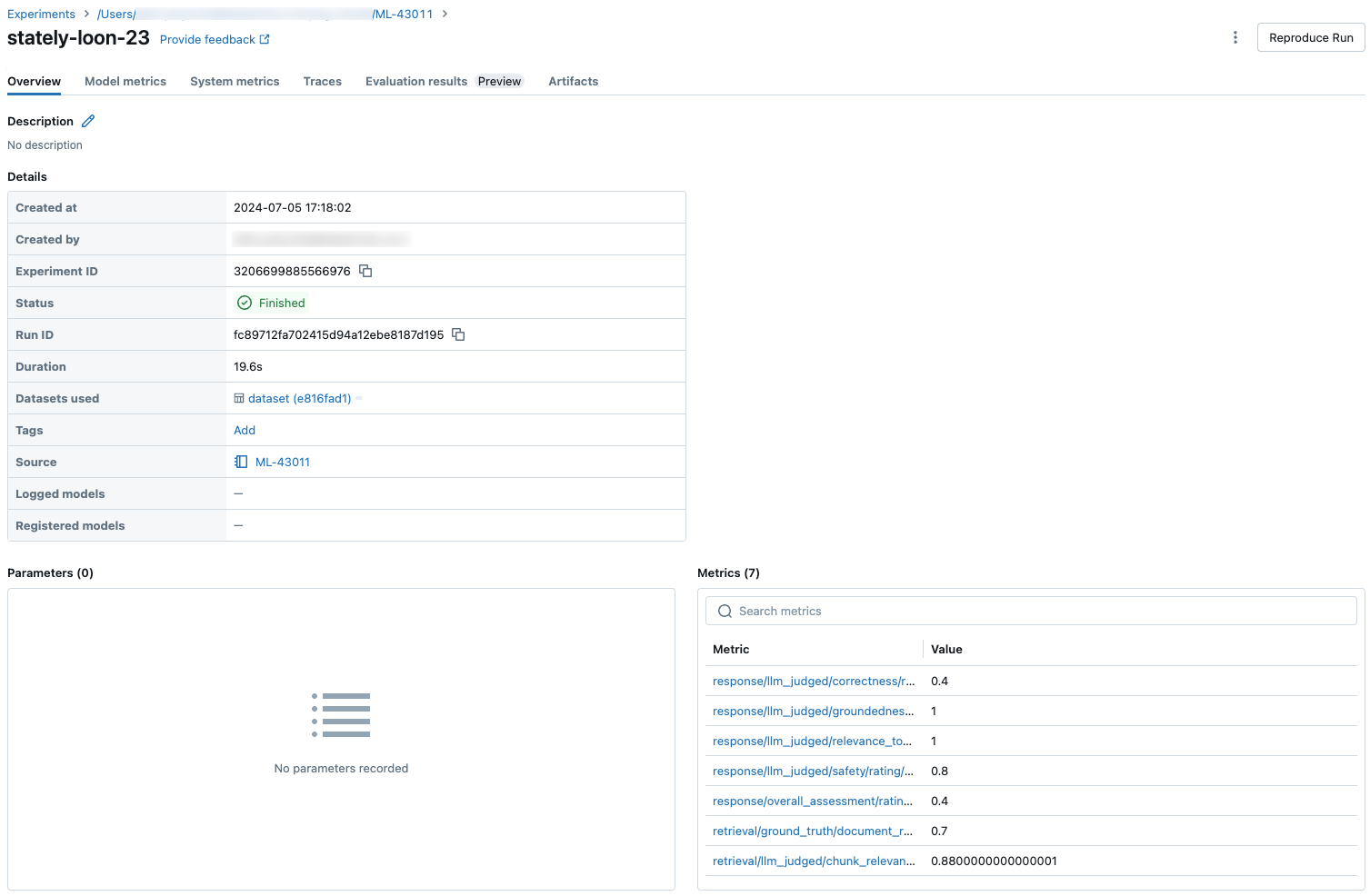
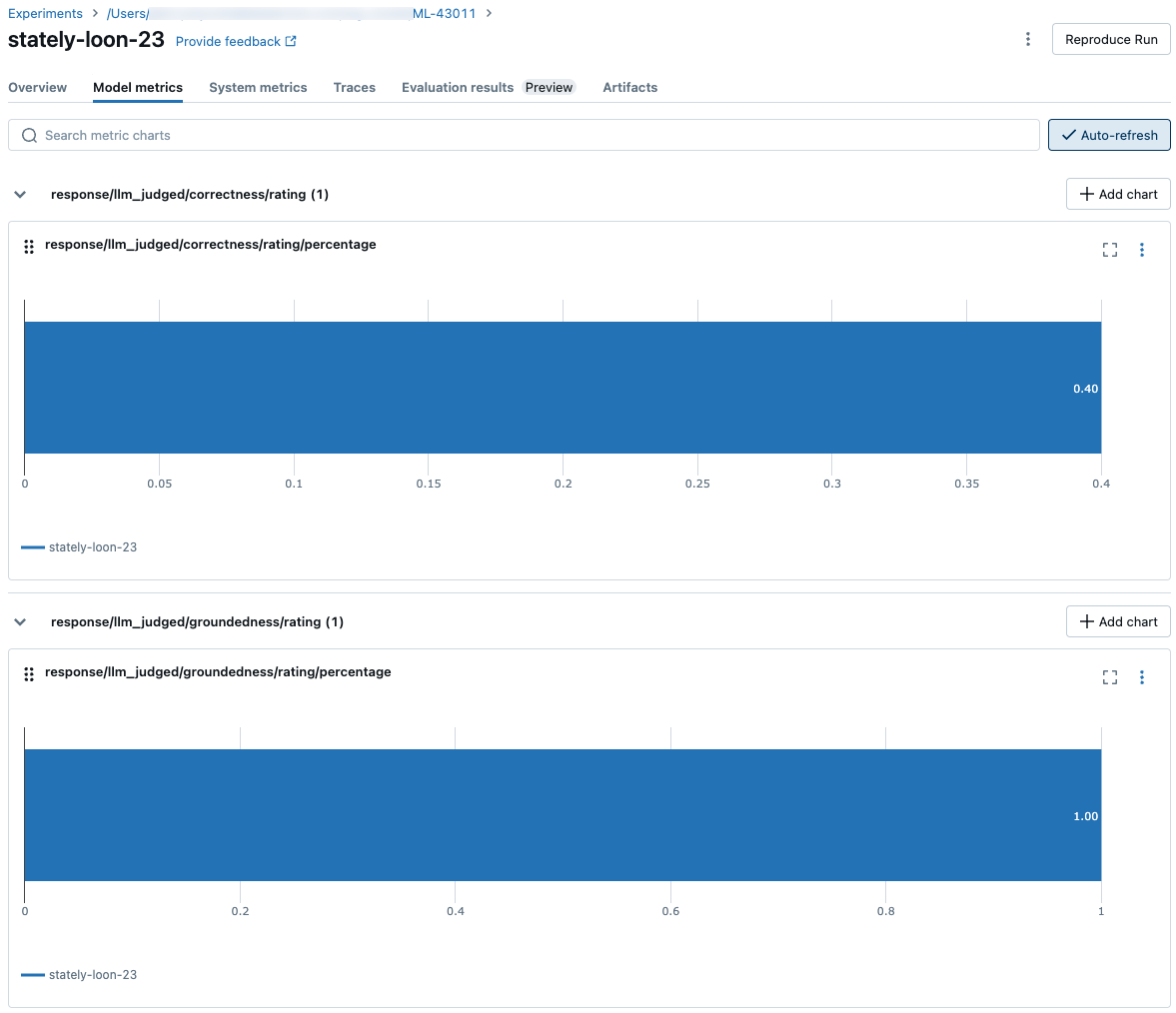
比较各运行中的评估结果
请务必比较各运行中的评估结果,以了解代理应用程序如何响应更改。 比较结果有助于了解更改是否对质量产生积极影响,或帮助你对更改行为进行故障排除。
比较各运行的每个请求结果
若要比较各运行每个单独请求的数据,请单击“试验”页面上的“评估”选项卡。 表格将显示评估集中的每个问题。 使用下拉菜单选择要查看的列。
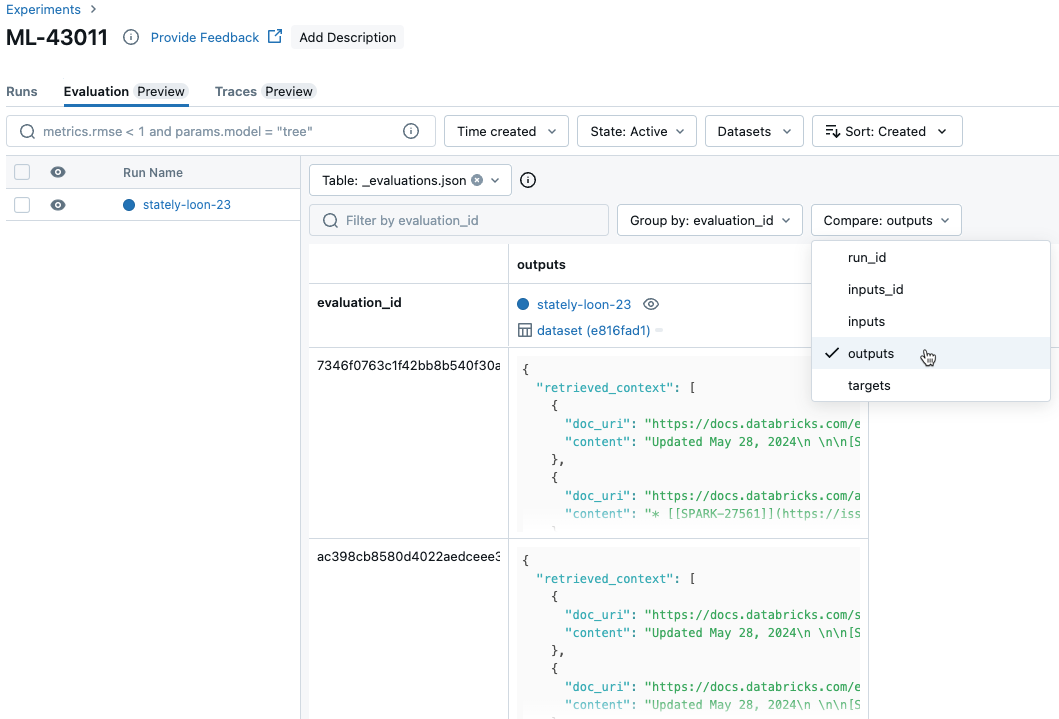
比较跨运行聚合的结果
可以从“试验”页访问相同的聚合结果,这也允许跨不同运行比较结果。 若要访问“试验”页面,请单击笔记本右边栏中的“试验”图标 ![]() ,或者单击运行
,或者单击运行 mlflow.evaluate() 的笔记本单元格的单元格结果中显示的链接。
在“试验”页上,单击 ![]() 。 这样,就可以直观显示所选运行的聚合结果,并将其与过去的运行进行比较。
。 这样,就可以直观显示所选运行的聚合结果,并将其与过去的运行进行比较。
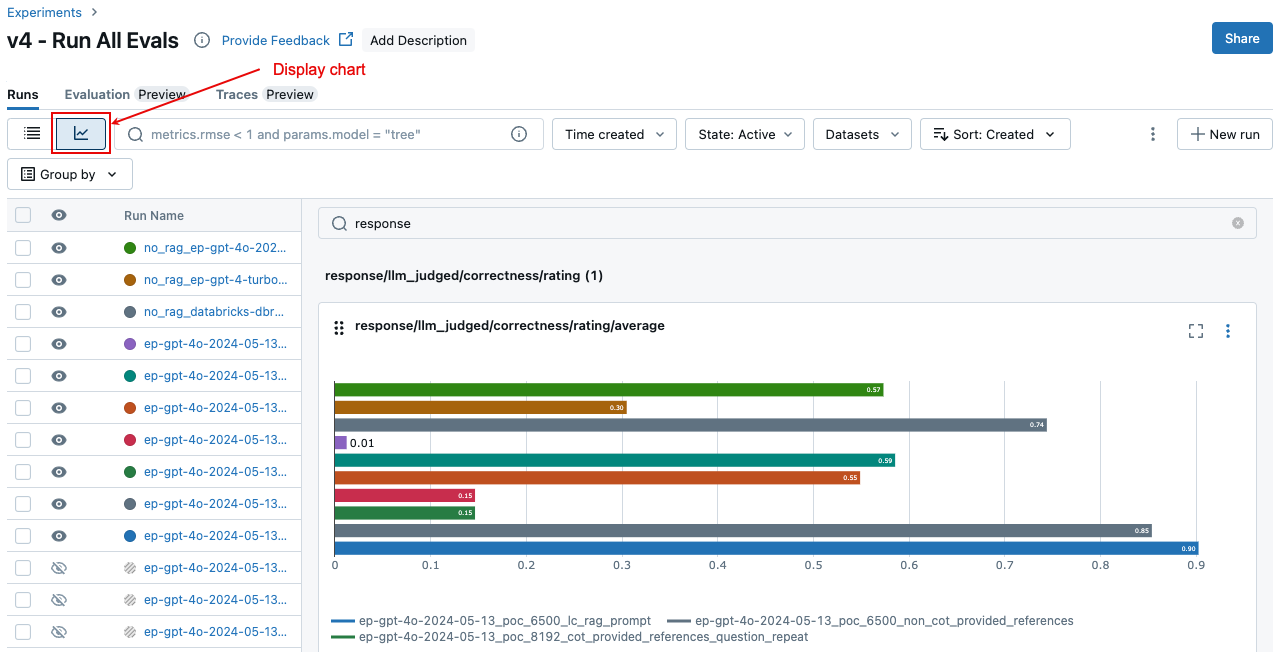
运行哪些评委
默认情况下,对于每个评估记录,马赛克 AI 代理评估会应用与记录中提供的信息最匹配的法官子集。 具体而言:
- 如果记录包含实况响应,则代理评估将应用
context_sufficiency和groundednesscorrectnesssafety评委。 - 如果记录不包括实况响应,代理评估将
chunk_relevance应用和groundednessrelevance_to_querysafety评委。
还可以使用参数明确指定要应用于每个请求的evaluator_configmlflow.evaluate()法官。
除了内置法官之外,还可以定义自定义 LLM 法官来评估特定于用例的条件。 请参阅 自定义 LLM 法官。
请参阅有关为 LLM 判定提供支持的模型的信息,了解 LLM 判定的信任和安全信息。
有关评估结果和指标的更多详细信息,请参阅 LLM 评委如何评估质量。
示例:如何将应用程序传递给代理评估
若要将应用程序 mlflow_evaluate()传递给该参数,请使用 model 参数。 参数中 model 传递应用程序有 5 个选项。
- 在 Unity 目录中注册的模型。
- 当前 MLflow 试验中的 MLflow 记录模型。
- 笔记本中加载的 PyFunc 模型。
- 笔记本中的本地函数。
- 已部署的代理终结点。
有关演示每个选项的代码示例,请参阅以下部分。
选项 1. 在 Unity 目录中注册的模型
%pip install databricks-agents pandas
dbutils.library.restartPython()
import mlflow
import pandas as pd
evaluation_results = mlflow.evaluate(
data=eval_set_df, # pandas DataFrame with just the evaluation set
model = "models:/catalog.schema.model_name/1" # 1 is the version number
model_type="databricks-agent",
)
选项 2. 当前 MLflow 试验中的 MLflow 记录模型
%pip install databricks-agents pandas
dbutils.library.restartPython()
import mlflow
import pandas as pd
# In the following lines, `6b69501828264f9s9a64eff825371711` is the run_id, and `chain` is the artifact_path that was
# passed with mlflow.xxx.log_model(...).
# If you called model_info = mlflow.langchain.log_model() or mlflow.pyfunc.log_model(), you can access this value using `model_info.model_uri`.
evaluation_results = mlflow.evaluate(
data=eval_set_df, # pandas DataFrame with just the evaluation set
model = "runs:/6b69501828264f9s9a64eff825371711/chain"
model_type="databricks-agent",
)
选项 3. 笔记本中加载的 PyFunc 模型
%pip install databricks-agents pandas
dbutils.library.restartPython()
import mlflow
import pandas as pd
evaluation_results = mlflow.evaluate(
data=eval_set_df, # pandas DataFrame with just the evaluation set
model = mlflow.pyfunc.load_model(...)
model_type="databricks-agent",
)
选项 4: 笔记本中的本地函数
该函数接收格式如下的输入:
{
"messages": [
{
"role": "user",
"content": "What is MLflow?",
}
],
...
}
该函数必须使用以下三种支持格式之一返回值:
包含模型的响应的纯字符串。
格式的
ChatCompletionResponse字典。 例如:{ "choices": [ { "message": { "role": "assistant", "content": "MLflow is a machine learning toolkit.", }, ... } ], ..., }格式的
StringResponse字典,例如{ "content": "MLflow is a machine learning toolkit.", ... }。
以下示例使用本地函数包装基础模型终结点并对其进行评估:
%pip install databricks-agents pandas
dbutils.library.restartPython()
import mlflow
import pandas as pd
def model(model_input):
client = mlflow.deployments.get_deploy_client("databricks")
return client.predict(endpoint="endpoints:/databricks-meta-llama-3-1-405b-instruct", inputs={"messages": model_input["messages"]})
evaluation_results = mlflow.evaluate(
data=eval_set_df, # pandas DataFrame with just the evaluation set
model = model
model_type="databricks-agent",
)
选项 5. 已部署的代理终结点
此选项仅在使用已部署 databricks.agents.deploy的代理终结点时有效。 对于基础模型,请使用选项 4 将模型包装在本地函数中。
%pip install databricks-agents pandas
dbutils.library.restartPython()
import mlflow
import pandas as pd
# In the following lines, `endpoint-name-of-your-agent` is the name of the agent endpoint.
evaluation_results = mlflow.evaluate(
data=eval_set_df, # pandas DataFrame with just the evaluation set
model = "endpoints:/endpoint-name-of-your-agent"
model_type="databricks-agent",
)
如何在调用中包含 mlflow_evaluate() 应用程序时传递评估集
在以下代码中, data 是具有评估集的 pandas DataFrame。 这些是简单的示例。 有关详细信息, 请参阅输入架构 。
# You do not have to start from a dictionary - you can use any existing pandas or Spark DataFrame with this schema.
# Minimal evaluation set
bare_minimum_eval_set_schema = [
{
"request": "What is the difference between reduceByKey and groupByKey in Spark?",
}]
# Complete evaluation set
complete_eval_set_schema = [
{
"request_id": "your-request-id",
"request": "What is the difference between reduceByKey and groupByKey in Spark?",
"expected_retrieved_context": [
{
# In `expected_retrieved_context`, `content` is optional, and does not provide any additional functionality.
"content": "Answer segment 1 related to What is the difference between reduceByKey and groupByKey in Spark?",
"doc_uri": "doc_uri_2_1",
},
{
"content": "Answer segment 2 related to What is the difference between reduceByKey and groupByKey in Spark?",
"doc_uri": "doc_uri_2_2",
},
],
"expected_response": "There's no significant difference.",
}]
# Convert dictionary to a pandas DataFrame
eval_set_df = pd.DataFrame(bare_minimum_eval_set_schema)
# Use a Spark DataFrame
import numpy as np
spark_df = spark.table("catalog.schema.table") # or any other way to get a Spark DataFrame
eval_set_df = spark_df.toPandas()
示例:如何将以前生成的输出传递给代理评估
本部分介绍如何在调用中 mlflow_evaluate() 传递以前生成的输出。 有关所需的评估集架构,请参阅 代理评估输入架构。
在以下代码中,是一个 pandas DataFrame, data 其中包含由应用程序生成的评估集和输出。 这些是简单的示例。 有关详细信息, 请参阅输入架构 。
%pip install databricks-agents pandas
dbutils.library.restartPython()
import mlflow
import pandas as pd
evaluation_results = mlflow.evaluate(
data=eval_set_with_app_outputs_df, # pandas DataFrame with the evaluation set and application outputs
model_type="databricks-agent",
)
# You do not have to start from a dictionary - you can use any existing pandas or Spark DataFrame with this schema.
# Minimum required input
bare_minimum_input_schema = [
{
"request": "What is the difference between reduceByKey and groupByKey in Spark?",
"response": "reduceByKey aggregates data before shuffling, whereas groupByKey shuffles all data, making reduceByKey more efficient.",
}]
# Input including optional arguments
complete_input_schema = [
{
"request_id": "your-request-id",
"request": "What is the difference between reduceByKey and groupByKey in Spark?",
"expected_retrieved_context": [
{
# In `expected_retrieved_context`, `content` is optional, and does not provide any additional functionality.
"content": "Answer segment 1 related to What is the difference between reduceByKey and groupByKey in Spark?",
"doc_uri": "doc_uri_2_1",
},
{
"content": "Answer segment 2 related to What is the difference between reduceByKey and groupByKey in Spark?",
"doc_uri": "doc_uri_2_2",
},
],
"expected_response": "There's no significant difference.",
"response": "reduceByKey aggregates data before shuffling, whereas groupByKey shuffles all data, making reduceByKey more efficient.",
"retrieved_context": [
{
# In `retrieved_context`, `content` is optional. If provided, the Databricks Context Relevance LLM Judge is executed to check the `content`'s relevance to the `request`.
"content": "reduceByKey reduces the amount of data shuffled by merging values before shuffling.",
"doc_uri": "doc_uri_2_1",
},
{
"content": "groupByKey may lead to inefficient data shuffling due to sending all values across the network.",
"doc_uri": "doc_uri_6_extra",
},
],
}]
# Convert dictionary to a pandas DataFrame
eval_set_with_app_outputs_df = pd.DataFrame(bare_minimum_input_schema)
# Use a Spark DataFrame
import numpy as np
spark_df = spark.table("catalog.schema.table") # or any other way to get a Spark DataFrame
eval_set_with_app_outputs_df = spark_df.toPandas()
示例:使用自定义函数处理来自 LangGraph 的响应
LangGraph 代理(尤其是具有聊天功能的代理)可以为单个推理调用返回多个消息。 用户负责将代理的响应转换为代理评估支持的格式。
一种方法是使用 自定义函数 来处理响应。 以下示例演示一个自定义函数,用于从 LangGraph 模型中提取最后一条聊天消息。 然后,此函数用于 mlflow.evaluate() 返回单个字符串响应,可以将其与 ground_truth 列进行比较。
示例代码做出以下假设:
- 模型接受采用 {“messages”: [{“role”: “user”, “content”: “你好”}]} 格式的输入。
- 模型返回格式为 [“response 1”, “response 2”的字符串列表。
以下代码以以下格式向法官发送串联响应:“response 1nresponse2”
import mlflow
import pandas as pd
from typing import List
loaded_model = mlflow.langchain.load_model(model_uri)
eval_data = pd.DataFrame(
{
"inputs": [
"What is MLflow?",
"What is Spark?",
],
"expected_response": [
"MLflow is an open-source platform for managing the end-to-end machine learning (ML) lifecycle. It was developed by Databricks, a company that specializes in big data and machine learning solutions. MLflow is designed to address the challenges that data scientists and machine learning engineers face when developing, training, and deploying machine learning models.",
"Apache Spark is an open-source, distributed computing system designed for big data processing and analytics. It was developed in response to limitations of the Hadoop MapReduce computing model, offering improvements in speed and ease of use. Spark provides libraries for various tasks such as data ingestion, processing, and analysis through its components like Spark SQL for structured data, Spark Streaming for real-time data processing, and MLlib for machine learning tasks",
],
}
)
def custom_langgraph_wrapper(model_input):
predictions = loaded_model.invoke({"messages": model_input["messages"]})
# Assuming `predictions` is a list of strings
return predictions.join("\n")
with mlflow.start_run() as run:
results = mlflow.evaluate(
custom_langgraph_wrapper, # Pass the function defined above
data=eval_data,
model_type="databricks-agent",
)
print(results.metrics)
限制
对于多轮对话,评估输出仅记录对话中的最后一项。
有关为 LLM 判定提供支持的模型的信息
- LLM 判定可能会使用第三方服务来评估 GenAI 应用程序,包括由 Microsoft 运营的 Azure OpenAI。
- 对于 Azure OpenAI,Databricks 已选择退出“滥用监视”,因此不会通过 Azure OpenAI 存储任何提示或响应。
- 对于欧盟 (EU) 工作区,LLM 判定使用托管在 EU 的模型。 所有其他区域使用托管在美国的模型。
- 禁用 Azure AI 支持的 AI 辅助功能即会阻止 LLM 判定调用 Azure AI 支持的模型。
- 发送到 LLM 判定的数据不用于任何模型训练。
- LLM 判定旨在帮助客户评估其 RAG 应用程序,LLM 判定输出不应用于训练、改进或微调 LLM。